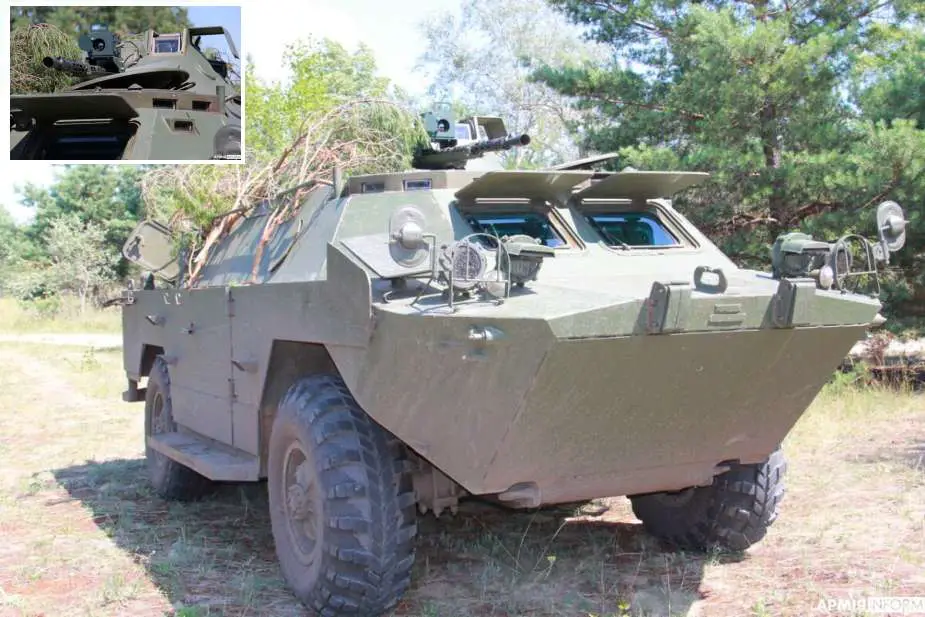- Army
- Conflicts in the world
- Israel - Iran conflict 2025
- Pakistan - India Conflict 2025
- Russia Ukraine War 2022
- Libya conflict day by day
- HAMAS - Israel War 2023
- Operation Serval in Mali French Army
- Sangaris operation Central African Republic
- Sangaris opération militaire République Centreafrique
- Ukraine - Russia conflict
- Syria conflict news
- Defence & Security Industry Technology
- Armies in the world
- Analysis Defense and Security Industry
- Conflicts in the world
- Navy
- Air
Ukrainian volunteers modernize BRDM-2 for enhanced combat capabilities
According to an article by Armyinform on August 15, 2023, Ukrainian volunteers and soldiers from the separate Volyn Brigade TrO collaborated to modernize a BRDM-2 reconnaissance vehicle. This modernization effort aimed to significantly enhance the vehicle's combat effectiveness, survivability, and versatility on the Ukrainian frontline.
Follow Army Recognition on Google News at this link

The Ukrainian Volyn Brigade has given the modernized BRDM-2 the nickname "Vovkulaka" (Picture source Armyinform)
The Russian invasion of Crimea in 2014 acted as a catalyst for Ukrainians to bolster their military technology and weaponry. This prompted the development of technical solutions intended to bolster combat capabilities.
For example, this specific BRDM-2 instance, named Vovkulaka, an aging vehicle dating back to the 1960s, had been unused for a substantial period and required extensive work to be operational again.
The primary modification encompassed replacing the original Soviet gasoline engine with a more powerful and efficient German diesel engine sourced from a Mercedes truck capable of supporting loads up to seven tons. Additionally, the water jet propulsion system and retractable wheels were removed from the vehicle. These adjustments collectively aimed to enhance the vehicle's armor protection and overall performance, enabling it to navigate various terrains and maintain operational readiness more effectively.
Further adaptations involved adding side doors to facilitate efficient troop deployment, focusing on quick and convenient embarkation and disembarkation. The interior floor was leveled, allowing the vehicle to transport wounded personnel or large cargo items to the frontline.
Offensive capabilities were also revamped. The original Soviet turret was swapped with a similar one taken from a destroyed Russian armored personnel carrier (APC). This upgrade equipped the vehicle with the ability to engage ground-based targets and low-flying threats during both day and night.
The modernization was driven by the limitations of the vehicle's older Soviet gasoline engine, inadequate armor protection, and firepower to meet contemporary challenges. Modifications were necessary for operations on sandy terrain, common in the region. These included replacing the power steering system (using the steering wheel from a civilian Ford Transit minibus) and enhancing the engine cooling system.
Volunteers tested the updated vehicle's mobility during its transportation to frontline positions. The increased armor led to a one-third weight increase, though it also resulted in smoother motion. The robust engine effortlessly tackled sandy inclines, showcasing improved dynamic characteristics. The vehicle's highway speed, restricted to approximately 60 km/h, was attributed to the constraints of the outdated Soviet transmission. Future plans involve replacing it with a more modern alternative.
Modernizing existing military vehicles like the BRDM-2 offers practical benefits for Ukraine's defense strategy. This approach proves cost-effective compared to developing entirely new vehicles, as it makes use of existing platforms and minimizes resource allocation. Additionally, the modernization process reduces the time required for development, enabling quicker deployment of upgraded assets to the frontline. This is particularly useful for responding promptly to evolving security challenges and dynamic battlefield conditions.
Furthermore, repurposing components from other vehicles, such as integrating a German diesel engine and a Russian armored personnel carrier turret, demonstrate resourcefulness in utilizing available materials. Salvaging parts from decommissioned or damaged vehicles underscores a sustainable approach, which aligns with prudent resource management principles.
From a combat and soldier readiness perspective, modernizing the BRDM-2 brings practical advantages. Given the BRDM-2's established service history, soldiers' familiarity with the vehicle is an asset. Modernizing the BRDM-2 preserves continuity in training and operational familiarity, facilitating a seamless transition for soldiers. This minimizes the need for extensive retraining on new equipment and ensures efficient deployment of troops.
Moreover, the modernized BRDM-2 has the potential to positively impact soldier morale. Recognizing that equipment is being improved and adapted to contemporary demands can enhance soldiers' confidence and motivation on the battlefield. This boost in morale can contribute to a more determined and resilient mindset among troops.
The upgraded armor and design of the BRDM-2 translate into practical benefits in terms of soldier protection and tactical utility. Improved armor increases the vehicle's ability to withstand a broader range of threats, including small arms fire, shrapnel, and certain light anti-armor weaponry. This heightened protection is crucial in ensuring the safety of soldiers within the vehicle and enhancing its effectiveness in diverse combat situations.


























